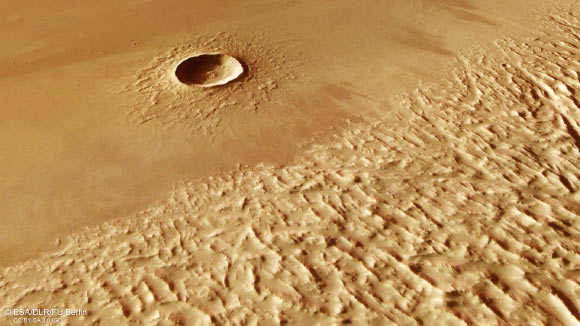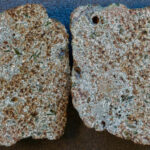Lava flows on Olympus Mons probably melted ice in the ground, making the volcano flank unstable; rockfalls and landslides moved hundreds of km into the surrounding landscape, forming a characteristic ‘wrinkled’ landscape there; today, steep escarpments form the base of Olympus Mons, exposing its 600-km-wide ‘plinth.’
This oblique perspective view of Lycus Sulci and Yelwa Crater on Mars was generated from the digital terrain model and the nadir and color channels of the High Resolution Stereo Camera on ESA’s Mars Express. It shows the large 8-km-wide Yelwa Crater in the background, while the wrinkled terrain of Lycus Sulci dominates the foreground. These features lie on the edge of the ‘aureole’ of Olympus Mons. Image credit: ESA / DLR / FU Berlin / CC BY-SA 3.0 IGO.
Mars is home to the largest volcanoes in the Solar System. The tallest of these is Olympus Mons, a giant shield volcano spotted in 1971 by NASA’s Mariner 9 spacecraft.
Olympus Mons is 21.9 km tall at its peak, about 2.5 times higher than Earth’s Mount Everest rises above sea level.
Mariner scientists spied not just Olympus Mons’ peak but also its surroundings, noticing an ‘aureole’ spreading out from the volcano’s base for hundreds of km.
This aureole in turn surrounds the volcano’s ‘basal scarp’, an immediate perimeter around Olympus Mons that is remarkably steep, hitting seven km tall in some places.
The new images from the High Resolution Stereo Camera (HRSC) on ESA’s Mars Express show a crumpled feature named Lycus Sulci, on the edges of the aureole; the volcano itself is located out of frame to the bottom left (south-east), many hundreds of km away.
The aureole tells the story of how Olympus Mons’ lower flanks catastrophically collapsed several 100 million years ago.
Large amounts of lava once flowed down the volcano, triggering landslides that tumbled down its flanks to meet bedrock — in this case, bedrock containing ice and water.
The swelteringly hot lava caused this ice to melt and become unstable; as a result, the rocky rim of Olympus Mons broke off and partially slid away.
This collapse came in the form of huge rockfalls and landslides, which slipped downwards and spread widely across the surrounding plains.
As the landslides moved away from Olympus Mons and traveled across the Martian surface they became alternately compressed and stretched — crumpled and pulled apart.
This created the characteristic wrinkles seen in these new images of Lycus Sulci.

This image from ESA’s Mars Express shows the wrinkled surroundings of Olympus Mons, the largest volcano not only on Mars but in the Solar System. This feature, created by previous landslides and lava-driven rockfalls, is named Lycus Sulci. This image comprises data gathered by the High Resolution Stereo Camera on January 18, 2023. It was created using data from the nadir channel, the field of view aligned perpendicular to the surface of Mars, and the color channels of the instrument. Image credit: ESA / DLR / FU Berlin / CC BY-SA 3.0 IGO.
Following its formation, Lycus Sulci became even more prominent over time as wind whipped across the Martian surface, eroding its material.
This wind also picked up dust and carried it far and wide across Mars, later scattering this fine sand over nearby hills and ridges.
Single landslides of the kind experienced by Olympus Mons can be hundreds of meters thick.
However, for this behemoth, which saw multiple colossal and overlapping collapses, they can be up to two kilometers thick.
This superposition of landslides can be seen clearly in the image; the wrinkled terrain to the right of the frame is older than the overlying crumples to the left, which flowed down the volcano’s slopes later in Mars’s history.
Despite their otherworldly dimensions, Mars’s volcanoes show similarities to those we see on Earth.
Comparable landslides — in type, if not in scale — can be seen around the volcanic islands of Hawaii and the Canary Islands, which have seen large rockfalls in the past.
Another feature highlighting the truly immense proportions of Olympus Mons can be seen to the right of the frame in Yelwa Crater.
Although dwarfed by the extensive Lycus Sulci, this crater is over 8 km in diameter — just shy of Mount Everest’s elevation above sea level.
Yelwa Crater is situated over 1,000 km from the peak of Olympus Mons, demonstrating just how far the destructive landslides traveled from the volcano’s flanks before settling.




